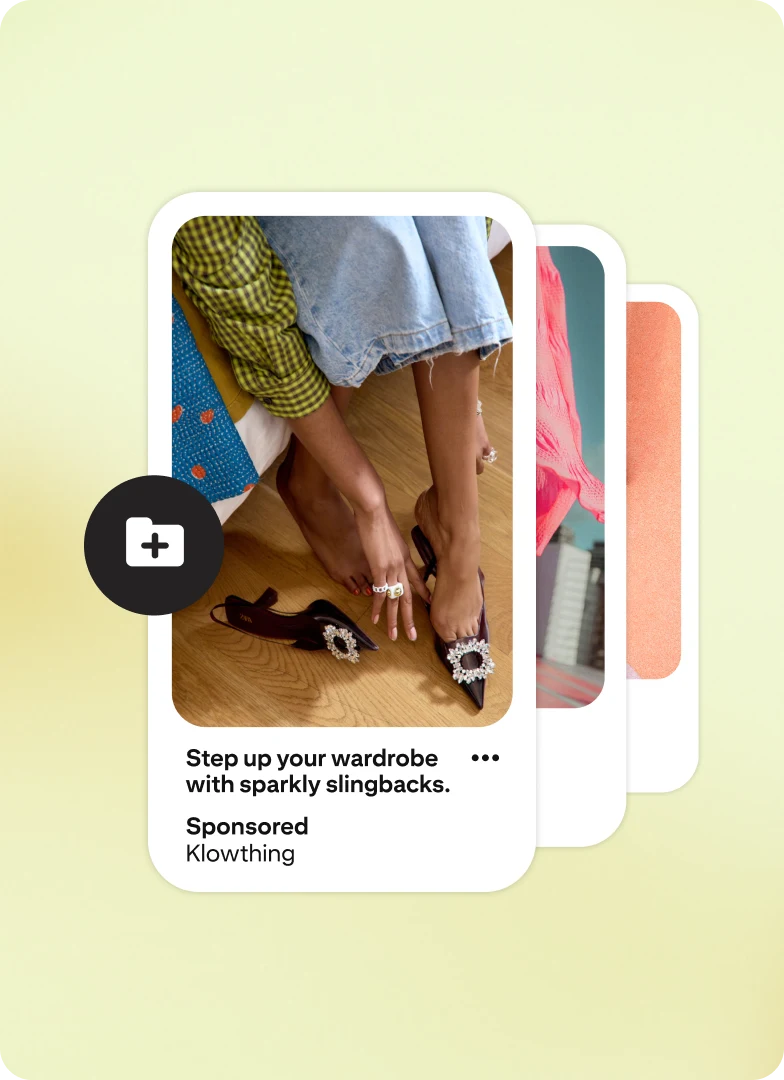A platform built for shopping
Your audience already uses Pinterest to shop. Reach people when they’re primed to buy and get better lower funnel results.
Better results, from start to cart
The #1 reason people use Pinterest is to discover new brands and products.1
People who use Pinterest weekly shop more often and spend more every month.2
New ad solutions are bringing brands even more outbound clicks and conversions.3
Step 1
Get ready to sell
If they can’t find it, they can’t buy it. Make product Pins to reach more shoppers and nudge them down the funnel.
Make product Pins
The Pinterest API for Shopping is the quickest way to upload large inventories. It’s best for brands that already use other APIs and manage complex product listings.
We offer seamless integration with Adobe Commerce, Salesforce Commerce Cloud, Shopify and Woo. Connect your storefront to Pinterest, and we’ll make Pins for your existing product listings.
If you don’t have a feed, you can manually tag products. You can even tag multiple products within the same scene. To do this, look for the “Add products” menu within the Pin creation tool.
Step 2
Scale results with ads
Boost success with campaigns tailored to lower funnel goals. Catalog sales campaigns require a product feed, while conversion campaigns do not. Choose based on your goals and setup or run both types for even more impact. For quicker setup and automated optimizations, enable Pinterest Performance+.
Catalog sales campaigns
Speed through setup with campaigns that pull from a product feed. Expanded targeting and dynamic retargeting make it simple to reach the right audience, while optimized bidding helps ensure results. You can promote specific products or use personalized Collections ads to show each shopper dynamic creative.

Conversion campaigns
Conversion campaigns include goals like add to carts, online sales and offline sales. They’re great for brands that don’t have a product feed or want more flexible targeting. Promote individual products or use multi-asset formats to showcase multiple items at once. Then, use optimized bidding for the best results.

Step 3
Ensure a seamless checkout
Make it easy for shoppers to buy with special enhancements. Ad formats with direct links take people directly from your ad to your site or store, removing the closeup step. Mobile deep links ensure people land on a specific product listing on your site or app.
You can also use sales and promotional features on image, video or shopping ads. These features can help draw attention to promotions, seasonal sales and product discounts.

Step 4
Measure and optimize
Make sure to add the Pinterest tag and enable the Conversions API. These tools help connect the dots between actions on Pinterest and actions elsewhere.
Monitor results as you go with Pinterest Analytics and Conversion Insights, then use campaign reporting for wrap results. Your Pinterest team can also set up custom studies for metrics like conversion lift or in-store traffic.
Work with one of our approved partners to go deep on cross-channel impact. Tools like multi-touch attribution or media mix modeling help you compare results and efficiency.
Brand spotlights
Enhanced performance
The exercise brand Sweaty Betty ran shopping campaigns with direct links, driving an uptick in customers to their site and allowing customers to purchase from their site in fewer steps. Pinterest emerged as the brand’s top-performing channel, with a 34% lower cost per action.4

A ROAS makeover
Lancôme added their product feed to Pinterest, making every product shoppable. This helped boost results during the holiday season, including optimized ROAS.5

A foot traffic windfall
With engaging creative and trending Pinterest search terms, Michaels crafted a winning conversion campaign. The company reached shoppers at every stage of the funnel and saw a 120% lift in foot traffic.6

Get started
Frequently asked questions
Anyone with a business account can tag products and create product Pins. To access additional features and ads, your business will need to go through a merchant review process. Learn more in our merchant guidelines.
It’s free to put your products on Pinterest, and you can even tag products in organic Pins. You’ll only pay if you decide to run campaigns.
Nope! Pinterest doesn’t charge to add products to the platform or take a commission from anything you sell.
Instead of having a dedicated place on the platform for shopping, shopping is native to the whole Pinterest experience. That reflects how people actually use Pinterest to shop: They’re looking at brands and products across the entire platform rather than in one specific spot.
Rather than handling checkouts on Pinterest itself, we optimize for high-quality handoffs to your own app or site. For many Pin formats, you can use direct links or mobile deep links to reduce friction and streamline the buying process. These features send people directly to your site or app, removing the close-up step you may see on other Pins.
First, make sure you’re following our creative best practices and creating inspiring, actionable content. You can also apply for the Verified Merchant Program for additional merchant features. Eligible brands get a “verified” badge on their profile and access to other exclusive features. You can learn more about organic resources for merchants on the Pinterest Create site.
